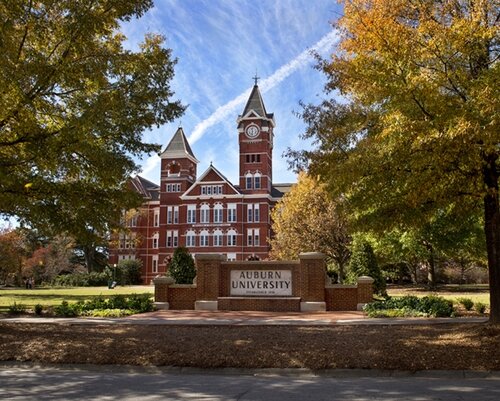Auburn University: Samford Hall’s clock tower to receive needed upgrades
Samford Hall’s clock tower will receive a much-needed facelift Sept. 26-27 that will ensure it remains a campus symbol for decades to come.
Currently utilizing vinyl clock faces, the vinyl and numerals will be replaced with industry standard acrylic. The bronze-cast numerals, part of the original clock faces from 1899, have deteriorated after years of cleanings and repairs.
“The existing clock faces in the Samford Hall clock tower are constructed of a vinyl material that is approaching the end of its useful life regarding durability and cleanability,” Facilities Management Director of Maintenance Eric Moore said.
This will be only the second time in the tower’s 133 years that the clock faces have been replaced, first undertaken in 1995, and the first time the numerals will be replaced.
Originally placed in 1889 after the completion of Samford Hall in 1888, “Big Sam,” as the tower structure was affectionally named in the ’40s, is one of the most important symbols in Auburn history. Placed while still part of the Alabama Polytechnic Institute, the clock faces are about 112 feet from the ground, situated on the tallest tower on campus, 154 feet at the roof and 176 feet at the weathervane.
The Samford Hall clock tower has undergone numerous repairs and upgrades in its life span, from the replacement of the manual chime system to an electronic carillon in 1977, then a newer one in 1995; the replacement of the original hand crank system in 1995, which required being cranked every week to keep proper time, to an electronic system; regular repainting and cleaning; to animal removal.
The coming repairs, however, are expected to last much longer and make future repairs much easier.
“The university is replacing the vinyl Samford Hall clock faces with an industry standard acrylic material that will extend the longevity and cleanability going forward,” Moore said.
While the clock tower, to some, is just a large clock that chimes on the hour and plays “War Eagle” at noon, to others, it may be one of the most important representatives of the university. It’s a place with hundreds of signatures, the site of numerous graduations and engagements, and one of the most consistently photographed areas across campus.
“The memory of the old clock is forever indelibly imprinted in the hearts of the men whom it has warned of approaching classes and drills,” reads the May 20, 1922, edition of the Orange & Blue newspaper. “The clock is old and wise, and could it talk, it could tell many strange and unknown tales of Auburn.”

